| |
Forschungsberichte
Vorträge
Publikationen
Projektversammlungen
Workshops
|
|
| The Expansion of Religious Pluralism in Europe:
|
| New Religious Movements from South Asia
in Barcelona |
 |
Fieldwork in Spain – November 2007
Thomas Gugler
| The concepts of pluralism, diversity, and geography
of religions are used here in consonance with the Pluralism
Project by Diana L. Eck´s (www.pluralism.org).
New Religious Movements are discussed here
in the context of Massimo Introvigne’s project page at www.cesnur.org .
The most astonishing common feature of New Religious Movements in Barcelona is their relative
invisibility compared to most other European countries.
Without having the exact address, most places of worship
for Non-Christians are practically untraceable.
The most prominent New Religious Movement of South Asian origin in Barcelona is ISKCON, the International Society of Krishna Consciousness, whose adherents, called
devotees, are widely known as Hare
Krishnas. The movement was founded 1967 by A. C. Bhaktivedanta Swami Prabhupada in the United States. As their mandir (temple) is the most important place
for Hindu-worship in Barcelona,
about 200 Indian families are connected to the ISKCON mandir. Since 1975 ISKCON has a temple in Barcelona and 1997 they bought the apartment,
which hosts the current mandir,
in Plaza Reial. It is mainly run by the temple
committee and eight devotees, who live in the very same
apartment.
|

Copyright © Thomas Gugler
|
Standing
in front of the door, there is no sign or symbol marking
the house as a Hindu place of worship. |
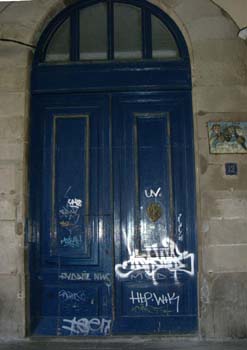
Copyright © Thomas Gugler
|
Under
the guidance of Srila
Prabhupada seventy women and men take darshan
of Sri Sri Gaur-Nitai during the weekly Sunday
festival here. |
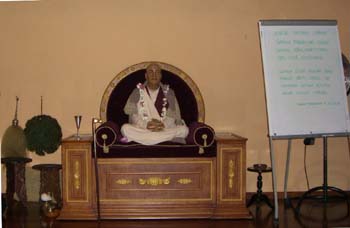
Copyright © Thomas Gugler
|
Sri Sri Gaur-Nitai refers to the historical founder of
Bengal Vaishnavism, Caitanya
Mahaprabhu, who is also named Gauranga
(Sanskrit for “being of golden colour”). He and his brother
Nityananda are believed to be incarnations of Krishna and Balarama. |
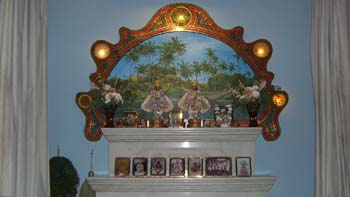
Copyright © Thomas Gugler
|
Since
1986 one of the devotees runs the Govinda-Restaurant
at Plaza Villa de
Madrid, where the purely vegetarian-Indian prasada,
the remnants of food offered to the Lord, is served by Christian
waiters. |
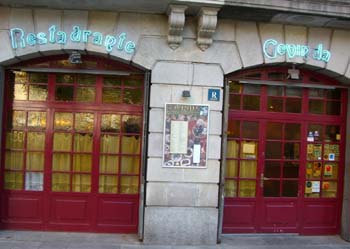
Copyright © Thomas Gugler
|
Barcelona hosts four Sikh gurudwaras. Though not exactly a New Religious Movement, the Gurdarshan Sahib Ji Gurudwara is, after
the Sri
Sri Gaur-Nitai
ISKCON Temple,
the second most important place of worship for immigrants
from India.
This biggest and most centrally located gurudawara
opened in August 2004 and hosts up to 1200 Sikhs on the
weekly Sunday festival. Every day this place invites for
kirtan and bhajan
(religious songs) at 1 pm, after which Punjabi food is served
for free at 2.30 pm. Besides Hindus and Muslims, Christians
are also invited to join and offer their obeisance. With
about 250 visitors every day this place is incredibly popular
among immigrants especially from India,
Nepal, and Sri Lanka. |

Copyright © Thomas Gugler
|
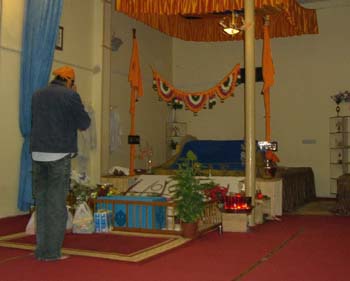
Copyright © Thomas Gugler
|
As many immigrants from India and practically all the immigrants from Pakistan and Bangladesh
are Muslims, Islam constitutes a special case among the
religions of the Diaspora communities in Spain.
|
|
Market Penetration in Muslim
Lands:
The Pluralisation of Islamic
Awakenings at the door to Al-Andulus
The most important place for worship by Muslims
from Bangladesh
is the Shah Jalal
Masjid (Mezquita in Spanish), established in 2006,
which calls itself also the Cultural
Center of Bangladesh. Bangladesh
is currently going through a process of Islamization, which
is causing many institutions to shift to a more purist interpretation
of Islam. The connection of Islam to ethnicity gives this
mosque a clear profile on the Muslim market in Barcelona.
|


Copyright © Thomas Gugler
|
Inside the mosque, four prayer rooms on two floors
invite Bangladeshi Muslims to recite the namaz. During my visit the large hall was surprisingly empty with
less than ten male Muslims joining salaat-e
´asr. |
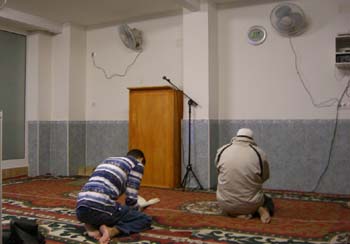
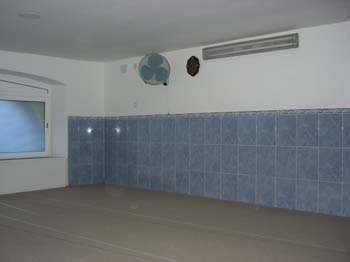
Copyright © Thomas Gugler
|
The obvious disparity between the mosque´s size
and the number of people congregating here for prayer raises
further questions, for instance about the funding. This
mosque is a meeting place for Ahl-e Hadith activists and has a close
cooperation with the Tarek
Ibn Ziyad Masjid, a cooperation, which becomes visible
for example during Ramadan. It cannot be stressed too much
that there is a strong need for research-projects on Bangladeshi
mosques in Europe. Mosques in Barcelona
are a well-known meeting point of often illegal immigrants
from Bangladesh and Pakistan,
who choose to go to Europe via Iran,
Turkey
and Greece. Some of them are known to
arrive in containers being shipped from Greece
to the port
of Barcelona. Some mosques are suspected to
promote illegal immigration, a fact, which would contravene
the state license, on which the mosque, among others, also
has to testify, that it is neither serving alcoholic drinks
nor running a restaurant. |
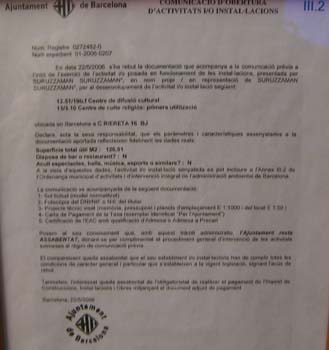
Copyright © Thomas Gugler
|
About a two minute walk from Shah Jalal and in the same street where
the central gurudwara
is, one finds the biggest mosque in
Barcelona
:
the Tarek bin Ziyad
Masjid, which is associated with the Islamic Missionary
Movement Tablighi Jama´at.
This movement was founded in
Mewat, India, in 1926. In Spain
,
where the movement is also called Dawa
al-Tabligh, it has been active since the 1970s. Media
reports identified mosques associated with the Tablighi
Jama´at as meeting points for the terrorists
of 11-M (11th March 2004). This controversy has led worshippers
congregating there to be suspicious of outsiders, especially when visitors show up for the first time.
Despite some distance
the authorities will always treat visitors correctly, though
the unfortunate hermeneutics of suspicion have increased
after a group of Moroccans was
suspected for preparing a bomb attack in Barcelona in summer
2007. (See the Article in the Daily al-Pais).
This might be one of the reasons why the mosque is not recognizable
as a place of worship from the main street (though there
is a board at the back-entrance, which opens to a street
with high traffic of prostitutes and drug dealers, many
of whom come from African countries).
|

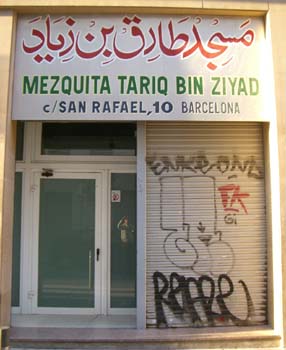
Copyright © Thomas Gugler
|
Inside the mosque three floors give space for
over a thousand worshippers who join in for the Friday-prayers.
|
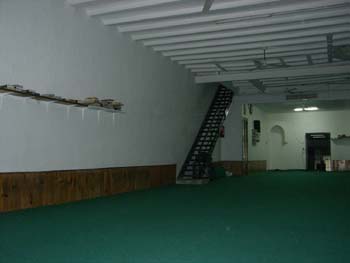
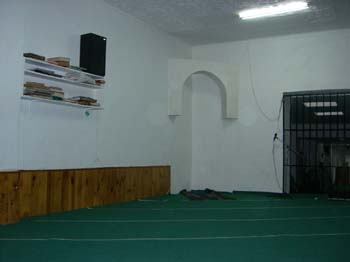
Copyright © Thomas Gugler
|
The second floor also hosts a madrassa, a place where children and converts
can learn Qur´an
and study the Faza´il-e
´Amal, the main publication of the movement, written
by Muhammad Zakariyya
(1898-1982), who was the nephew of the movement’s founder
Muhammad Ilyas (1885-1944). |

This would certainly be the place in Barcelona to locate Urdu
publications of the dar-ul-´uloom
in Deoband, which are mostly found in the
more private areas of the mosque.

Copyright © Thomas Gugler
|
As more than one thousand Muslims, mostly Africans
and Arabs from Tunisia
and Morocco,
recite the namaz
here on Fridays, some of them may have to line up outside
the building. However, most of the people in charge of the
masjid, among
them the person who instructs the people where to line up
(in the picture right), are immigrants from the Indian subcontinent. |

Copyright © Thomas Gugler
|
The Tablighi
Jama´at runs also the much smaller An-nour
Masjid at Jaume
l, which has an area of about 150 square meters if one
is willing to count the upper floor, which serves as a place
to sleep and cook for Tablighi preachers during khuruj
mostly. In both Mosques one may find Arab lay-preachers,
mostly from Morocco,
almost during the entire day. |

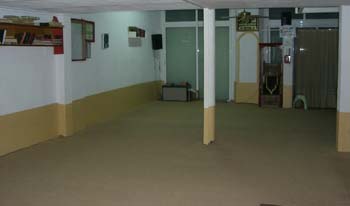
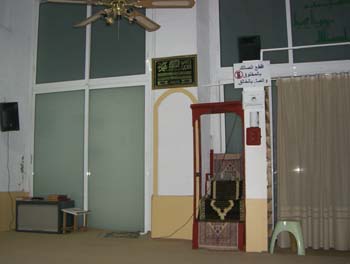
Copyright © Thomas Gugler
|
The two mosques of the Tablighi Jama´at preach a Sunni Islam connected to the school of Deoband, in Northern India. As most Muslims from South Asia would more
likely consider themselves Barelwi
(Ahl-e Sunnat),
it is not surprising, that there are more Ahl-e
Sunnat mosques in Barcelona.
The biggest Barelwi
masjid in central Barcelona
is the new Centro
Cultural Camino de la Paz in
Sant Antoni, which just opened on 7th September
2007 and is run by the Minhaj
al-Qur´an movement. The movement was founded 1980 in
Lahore, Pakistan, by Dr. Muhammad Tahir ul-Qadri (born 1951),
the author of Nizam-e
Mustafa. It is active in Spain since 1987. As many mosques struggle with the license from the Spanish State, there
is not the smallest hint on the door that a mosque could
be hidden behind it. In order to apply for the State license
mosques are asked among other things to give proof of an
emergency exit, a toilet accessible by wheelchair, and the
use of non-flammable praying carpets.
|
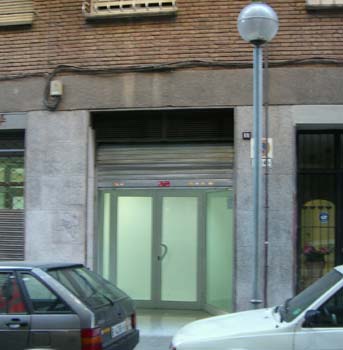
Copyright © Thomas Gugler
|
Inside
the mosque a large prayer room with an area of around 400
sqare meters invites also the Arab youth to join the recitation
of the namaz. |

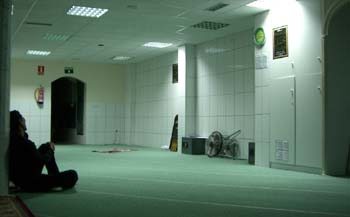
Copyright © Thomas Gugler
|
Since 1996 the Minhaj ul-Qur´an runs an approximately 300 square meter-large mosque
in Arc de Teatre. |
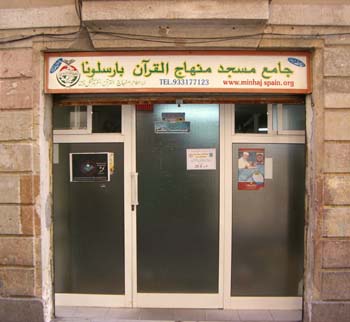

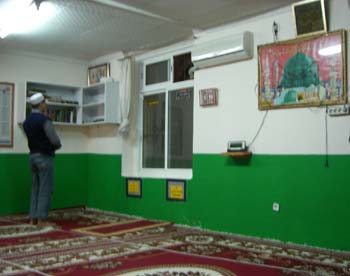
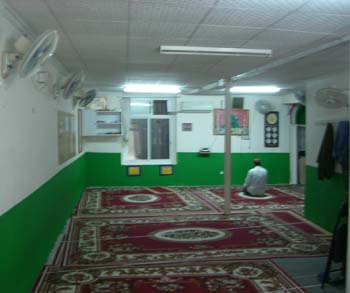
Copyright © Thomas Gugler
|
The only Ahl-e
Sunnat mosque of Barcelona,
which has two floors, is located in one of the suburbs,
called Besos. The Centro De Cultura Jamia Masjid Ghulmane Mustafa Catalunya opened in
2004. |
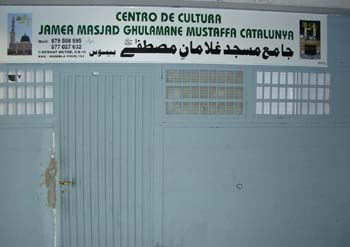
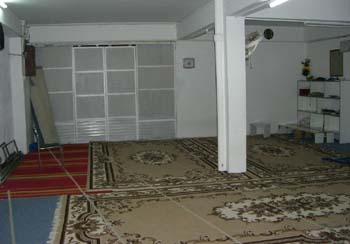
Copyright © Thomas Gugler
|
It also hosts a modest madrassa for children. The upper floor also has some private rooms
in which the Imam can spend the night. The writing of the
poster on the wall literally says: “I love Da´wat-e
Islami”, which is a Missionary Movement founded 1981
in Karachi, Pakistan, by Maulana Muhammad Ilyas Qadri Attar (born
1950). |
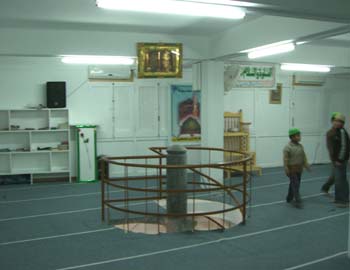
Copyright © Thomas Gugler
|
The Da´wat-e
Islami also runs its own mosque, which the Mosque Comittee
prefers to call “centre” or markaz,
in central Barcelona. The mosque is
called Faizan-e Madina
and was inaugurated by British representatives of the movement
in April 2007. Though the Faizan-e Madina with its rougly 180 square
meters is not the largest mosque, it usually attracts about
200 to 250 Muslim worshippers, mostly immigrants from Pakistan, to join the namaz on Fridays. The donations of the
people congregating for the Friday prayers can merely fund
the monthly rent of 1.500 EUR. Sine the mosque’s modest
budget is unable to pay for other expenses, for instance
pay the Imam, he makes his own
living by running a PCO shop (Locutorio
in Spanish) on the side. |
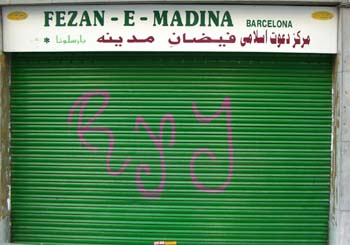
Copyright © Thomas Gugler
|
The movement celebrates a weekly ijtema´ for the brethren on Saturday from
´asr to maghreb (including both). During
this ceremony, a lay-preacher recites na´at
(prayers of praise) from the Mukhilan-e
Madina written by Muhammad
Ilyas Attar. About seventy women congregate here for
the ijtema´ of the sisters, which takes place on Saturdays between zohr and ´asr. This is the time between the prayers, when the mosque is not
occupied by men. This gathering is modelled after the program
for the brethren, though headed by a woman-preacher who
is the sister of the Imam. All sermons are given in Urdu
and inspired by the Rasail-e
Attariya. |

Copyright © Thomas Gugler
|
The 26-year-old Imam, who attracts the local Pakistani
youth, delivers the sermon during the Fridays´ prayers.
One cannot but recognize the poster on the wall, which we
have already seen in the Ahl-e Sunnat Masjid in Besos – declaring love to Da´wat-e Islami. |
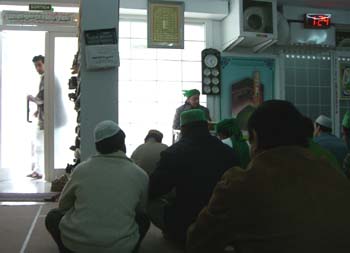
Copyright © Thomas Gugler
During the weekly congregation (ijtema´) on Sunday religious lectures (dars) are read by lay-preachers. Most dars are taken out of Ilyas Attar´s Faizan-e Sunnat (3rd
rev. Ed., Karachi:
Maktaba tul-Madina 2006).
|
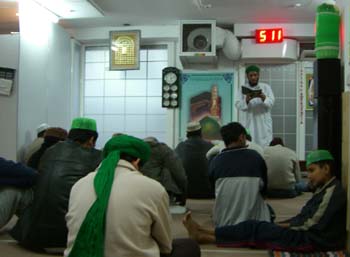
Copyright © Thomas Gugler
|
The Faizan-e
Madina Barcelona also hosts a madrassa.
Currently about ten girls and boys learn to read the Qur´an here.
|
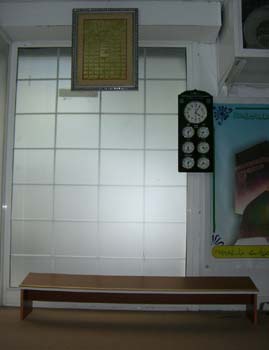
Copyright © Thomas Gugler
|
The Da´wat-e
Islami (Islamic Missionary) distributes its posters
to Pakistani shops in Barcelona. The poster highlights
the Friday prayers, to which more people visit the mosque
compared to the
ijtema´ gatherings of Sundays.
|

Copyright © Thomas Gugler
|
Besides little supermarkets, immigrants from Pakistan
mostly run PCOs, i. e. Internet and mobile shops called
Locutorio in Spanish, and specific Islamic stores, especially for
halal-meat (Carnicaria in Spanish). The posters of the Da´wat-e Islami can easily be noticed – by anybody who can read Urdu.
|



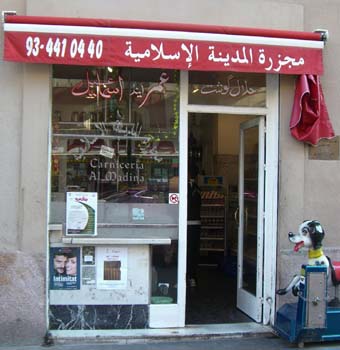
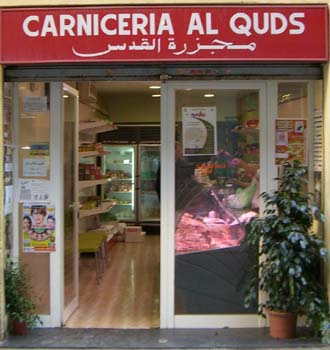

Copyright © Thomas Gugler
|
|
|
|